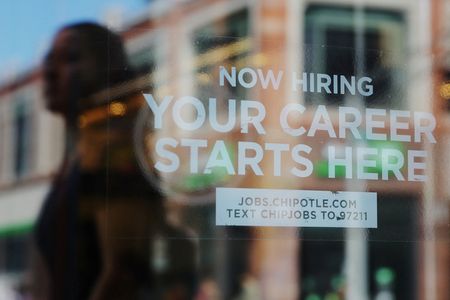By Lucia Mutikani
WASHINGTON (Reuters) – U.S. job openings dropped to a 3-1/2-year low in July, suggesting the labor market was losing steam, but the reduction on its own is probably not enough to warrant a half-percentage-point interest rate cut by the Federal Reserve this month.
The larger-than-expected decline in unfilled jobs shown in the Job Openings and Labor Turnover Survey, or JOLTS report, from the Labor Department on Wednesday meant there were 1.07 open positions for every unemployed person in July. That was the least since May 2021 and down from 1.16 in June. The vacancies-to-unemployed ratio peaked just above 2.0 in 2022.
Still, the labor market is likely not deteriorating. A separate report from the Fed described employment levels as “generally flat to up slightly in recent weeks.”
The labor market is being closely watched by investors and policymakers following four straight monthly increases in the unemployment rate, which stoked fears of a recession. Economists are sticking to their forecasts for a 25-basis-point rate cut at the U.S. central bank’s Sept. 17-18 meeting. Much depends on the employment report for August, which is due to be published on Friday.
“Does this report suggest the need for a 50-basis-point rate cut in September?” asked Conrad DeQuadros, senior economic advisor at Brean Capital. “We would say no because … the vacancies-to-unemployed ratio is still high by historical standards.”
Job openings, a measure of labor demand, had fallen by 237,000 to 7.673 million on the last day of July, the lowest level since January 2021, the Labor Department’s Bureau of Labor Statistics said. Data for June was revised lower to show 7.910 million unfilled positions instead of the previously reported 8.184 million.
Economists polled by Reuters had forecast 8.100 million job openings. Vacancies peaked at 12.182 million in March 2022 and are down by 1.1 million over the year. The decline in open jobs was concentrated among small businesses.
Unfilled jobs declined by 187,000 in healthcare and social assistance and decreased by 101,000 in state and local government, excluding education. These two are among a handful of sectors that have driven job growth this year.
The transportation, warehousing and utilities sector had 88,000 fewer open positions. But job openings increased by 178,000 in the professional and business services category and there were 28,000 vacancies in the federal government. The job openings rate fell to 4.6%, the lowest level since December 2020, from 4.8% in June.
Hires increased by 273,000 to 5.521 million. They rose by 156,000 in accommodation and food services, but decreased by 8,000 in the federal government. The hires rate rose to 3.5% from 3.3% in June.
Layoffs rose 202,000 to 1.762 million, the highest level since March 2023. Layoffs, however, remain low by historic standards. The rise in July was led by an increase of 75,000 in accommodation and food services as well as an advance of 21,000 in finance and insurance.
The layoffs rate rose to a still-low 1.1% from 1.0% in June. Low layoffs were underscored on Wednesday in the Fed’s “Beige Book” report, which reported that five of the U.S. central bank’s districts saw slight or modest increases in overall headcounts in late August.
It, however, noted that “a few districts reported that firms reduced shifts and hours, left advertised positions unfilled, or reduced headcounts through attrition, though accounts of layoffs remained rare.”
Financial markets saw less than a 50% chance of a half-percentage-point rate reduction this month, according to CME Group’s FedWatch Tool. A 50-basis-point rate reduction was also put in doubt by strong consumer spending in July.
Stocks on Wall Street were trading lower and the dollar slipped against a basket of currencies. Prices of U.S. Treasuries rose.
TRADE DEFICIT WIDENS
“The labor market is still in pretty good shape, but it has cooled dramatically over the last year and a half,” said Bill Adams, chief economist at Comerica Bank. “Most Americans who want jobs have them, but there are fewer opportunities or alternatives for workers who are laid off or simply prefer something different.”
Solid domestic demand was reinforced by other data from the Commerce Department’s Bureau of Economic Analysis on Wednesday which showed a surge in imports pushed up the trade deficit 7.9% to $78.8 billion in July, the widest since June 2022.
Imports rose 2.1% to $345.4 billion. Goods imports jumped 2.3% to $278.2 billion, the highest since June 2022. Capital goods imports increased $3.3 billion to a record high, mostly reflecting computer accessories.
While the increase in imports would subtract from gross domestic product, it highlighted the economy’s resilience. Businesses are also likely front-loading imports in anticipation of higher tariffs on goods.
President Joe Biden’s administration has announced plans to impose steeper tariffs on imports of Chinese electric vehicles, batteries, solar products and other goods.
The government said last week a final determination will be made public in the “coming days.” There are also fears of even higher tariffs on Chinese imports should former President Donald Trump return to the White House after the Nov. 5 election.
The politically sensitive goods trade deficit with China increased $4.9 billion to $27.2 billion.
Exports gained 0.5% to $266.6 billion. Goods exports climbed 0.4% to $175.1 billion. The goods trade deficit increased 6.9% to $97.6 billion after adjusting for inflation.
Trade has subtracted from GDP for two straight quarters. Most of the imports are, however, likely to end up as inventory amid slowing domestic demand, which could blunt some of the impact on GDP. Goldman Sachs lowered its third-quarter GDP growth estimate to a 2.5% annualized rate from a 2.7% pace. The economy grew at a 3.0% pace in the second quarter.
“Net trade will weigh on third-quarter GDP growth, but that is hardly cause for concern when it reflects the continued strength of imports, painting a better picture of domestic demand than renewed recession fears would suggest,” said Thomas Ryan, North America economist at Capital Economics.
(Reporting by Lucia Mutikani; Editing by Emelia Sithole-Matarise, Andrea Ricci and Paul Simao)





